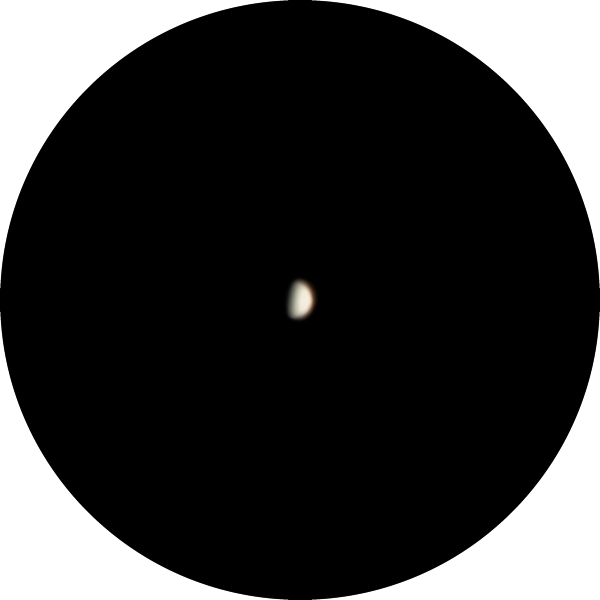iPhone Moon, Venus, Orion Nebula
Posted: 5 March 2020
After dawning clear on Thursday, 27 February 2020, the sky become overcast mid-afternoon. Had 0.08" rain Tuesday morning, 3 March. Cloudy skies continued until Wednesday, 4 March.
|
Open: Wednesday, 4 March 2020, 1809 MST Temperature: 79°F |
Session: 1445 Conditions: Mostly clear |
Equipment:
12" f/8 LX600 w/StarLock
2" 24mm UWA eyepiece
2" 30mm eyepiece
2" 9mm 100° eyepiece
Camera:
iPhone 11 Pro Max
D850 DSLR
1815 MST: LX600 ON, StarLock OFF, High Precision OFF.
On the initial power on the GPS date was in January 2080 and the time (which was correct) was set to AM/PM instead of 24 hour (which I always use). I do not know if this error was from the GPS rollover issue that occurred in April 2019, but it was the first time I have seen this strange date from the GPS. I manually corrected the date (the time was correct) and slewed the telescope to the Moon. The telescope pointed about 60° too far to the east of the Moon. I slewed to Venus with the same result. I checked the location, date, time, DST, and GPS Offset and all were correct. I Parked the telescope, powered OFF, and then back ON. This time everything came up OK and slewing was accurate. Not certain what happened with the initial power on.
1823 MST: sunset.
Viewed the waxing gibbous Moon, 102X and 81X.
Mounted the iPhone 11 Pro Max on the 30mm eyepiece using the Levenhuk adapter. Took this afocal 81X photo using NightCap Camera (ISO 32, 1/900sec, 1X lens).

Then viewed Venus, 102X. It was almost a half phase. Switched to 271X. Seeing was not very good. Took this handheld afocal 271X photo of Venus using NightCap Camera (ISO 21, 1/200sec, 2X lens).

Next, I viewed the Trapezium star cluster in M42 (Orion Nebula), 102X and 81X.
1848 MST: mounted the iPhone and took this afocal 81X photo with NightCap Camera (ISO 32, 1 second, 1X lens).

The four Trapezium stars are at the center.
1915 MST: with the sky now darker I used the iOS Camera app in "Night Mode" (5 seconds, 1X lens) for this afocal 81X image of the Orion Nebula.

I then began some initial tests of the iOS app SpiralCam (free). This app takes multiple images, aligns the images, and stacks the multiple images. As seen in this screen shot of the interface it can also do "darks" and more.

I used the app for this afocal 81X image of the Orion Nebula.

The exposure values are inserted at the upper left corner of the image and show this.
![]()
No other exposure information (ISO, shutter speed, date/time) is shown in the EXIF metadata for the images from SpiralCam. I have asked the developer to add that. I will likely post a review of the app after I do a lot more work with the app.
1934 MST: viewed M42 (Orion Nebula), 102X.
Took this D850 DSLR (focal length 300mm) photo of the lights shining brightly from a neighbor's new "greenhouse". I have not yet caught up with the neighbor to talk about it.

1939 MST: LX600 OFF.
|
Close: Wednesday, 4 March 2020, 1948 MST Temperature: 58°F |
Session Length: 1h 39m Conditions: Clear |
Notice: sometime later in March I expect to switch my domain from http to https. When the change occurs you should see the lock (or site secure) indicator in the address bar in your web browser. If you have bookmarked any of the pages on weasner.com you will want to update those bookmarks to have https instead of http. Don't make the change yet; I will post a notice on the Cassiopeia Observatory home page when it should occur.
Comments are welcome using Email. Twitter users can use the button below to tweet this report to their followers. Thanks.
Cassiopeia Observatory Home Page
Copyright ©2020 Michael L. Weasner / mweasner@me.com
URL = http://www.weasner.com/co/Reports/2020/03/05/index.html
